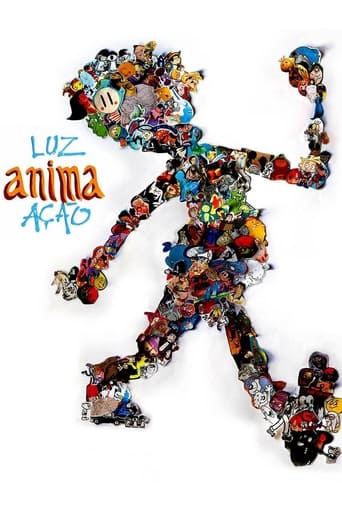Redwarmin
This movie is the proof that the world is becoming a sick and dumb place
Sarita Rafferty
There are moments that feel comical, some horrific, and some downright inspiring but the tonal shifts hardly matter as the end results come to a film that's perfect for this time.
antonipinent
<<'LUZ ANIMA AÇÃO' (Eduardo CALVET, 2013) welcomes us to a fortunate travel that follows the steps of Animation Film in Brazil and also abroad, with some animators (as well directors) working for big enterprises as Dreamworks and Disney. There also the importance of 'advertising' in the context Brazilian animation since long time ago.The documentary runs with rhythm in chronologically chapters explained almost entirely by the animators-researchers themselves, like the generous, ingenious and co-founder of ANIMA MUNDI Marcos MAGALHÃES. He brings his energy an enthusiasm, as long as others interviewers, providing their experiences and knowledge of each context of a particular time.Meanwhile the documentary is going on from the pioneers to nowadays, it develops also a brand new animation made by different filmmakers selected with several techniques ('cameraless', light painting, 2D, classic animation, etc.). The kick start is one single frame of Seth's missing 'O Kaiser', considered to be the first animation film from Brazilian history, as 'Cadavre exquis' having only the last frame from the precedent animator.There are really good material inside this CALVET's documentary, from the voices of the filmmakers and historians consulted to the archive and rare material well illustrated with graphic materials. For example, the almost unknown material from the pioneers, as well as the work from the great Avant-Garde 'cameraless' filmmaker Roberto MILLER.A really priceless work, specially for animation lovers worldwide.>>
john-canemaker
Between the Frames - The Art of Brazilian Animation a.k.a. Luz Anima Ação is an excellent educational film production that offers a thorough picture of the history of animation in Brazil, using interviews with various animators, artists, film historians and rare film clips. I found it an enlightening document, one that I highly recommend to film schools internationally. Of particular interest to me is the examination of small independent studios and artists who explored a diversity of individualistic styles and techniques, e.g., Roberto Miller, Chico Liberato, Otto Guerra, and Marcos Magalhaes, among many others. The clever thread throughout the film of current animators -- re-creating the lost earliest Brazilian 1917 animated film "Kaiser" by "Seth" (Alvaro Marins) -- is a fine idea, emotionally connecting the past with the present. -John Canemaker

